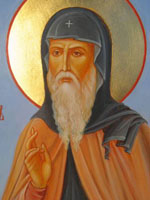Some time in the fourth century AD, a young man known as John Kolobos walked into the desert of Scetes in Egypt to join its many Christian monks and hermits. He was placed in the spiritual care of St Pambo. Handing John his walking stick, Pambo ordered him to plant it in the dusty ground and water it twice a day.
John carried out his duty without complaint for three years, though the nearest source of water lay far away. Then, one day, the stick suddenly sprouted into a tree and bore ripe fruit. 'Take,' said Pambo to his fellow monks, 'and eat from the fruit of obedience.'
John's reputation as a holy man grew. He was asked to secure the repentance of a young Egyptian woman called Paesia, who had fallen into disgrace. Visiting her house, he burst into tears at the thought of her sin, and eventually persuaded her to return to the desert with him. So complete was her repentance, however, that the Lord took her up to heaven before his very eyes.














